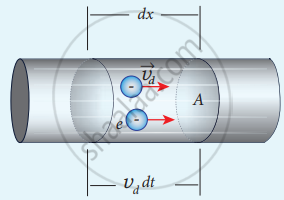Advertisements
Advertisements
Question
Describe the microscopic model of current and obtain general form of Ohm’s law.
Solution
- XY is a conductor of an area of cross-section A
- E is the applied electric field.
- n is the number of electrons per unit volume with the same drift velocity (vd)
Let electrons move through a distance dx in time interval dt.

Microscopic model of the current
`therefore "vd" = "dx"/"dt"`
dx = vd . dt …………(1)
Electrons available in the given volume
= volume × number per unit volume
= A. dx × n
= A . vd dt × n [From (1)]
Total charge in volume dQ = charge × number of electrons
dQ = (e) (Avd dt) n
w.k.t, I = `"dQ"/"dt"`
∴ I = `("neAv"_"d""dt")/"dt"`
I = nAevd .....(2)
Current density, J = `1/"A"`
∴ J = `("neAv"_"d")/"A"`
J = nevd
In vector form, `vec"J" = "ne" vec"V"_"d"`
Substitutingthe value of `vec"V"_"d" = ("e"tau)/"m"*vec"E"` .....(2)
`vec"J" = ("ne"^2tau)/"m"`
This is the microscopic form of Ohm's law
J = `sigma vec"E"`
`sigma = ("ne"^2tau)/"m"`
